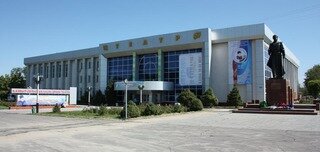Monuments
The ancient settlement Taraz
The ancient settlement of Taraz is a unique archeological monument. Cultural layers of Taraz dates back to the 1st-19th centuries and reflect entire history of Kazakhstan. Findings of the 10th -12th centuries – the time of the town's prosperity – are of prominent interest. Medieval Taraz was located in the territory of the nowadays central market around Mirzoyan, Tole by and Baizakov streets. The fundamental explorations of the Taraz settlement started in 2011.
The ancient settlement of Taraz was situated in crossings of trade ways. It consisted on citadel, rabad and shahrestan. Citadel and shahrestan of Taraz surrounded with walls as well as bath-house were in the territory of currentCentral market. In the place of diggings were found fragments of ceramics with writings in Arabic, pieces of ceramic crockery with images of crux. It serves as an evidence of peaceful coexistence of religions and confessions. In the south-east part of the citadel was located eastern bath-house. Inner walls of the premise consisted of dressing room, washing rooms, and rooms for procedures. Second bath-house of Kaln-Yunus was situated in opposite up the street of Baizak Batyr. It was of jblong form and build of burnt bricks. Ten premises of various types connect with arched passes were preserved in it. In some of the premises of the bath-house were conserved multicolored paintings on the walls – eight-pointed yellow stars in red and pink background encircled with black and arranged in chess order. The premises were overarched with dooms decorated inside with arches and figured exedras.
Moreover, ruins of ancient madrasah, large town main line and remainders of ancient water pipe were found in the territory of the settlement. In serves as an evidence of high level of cultural development in medieval Taraz. Buildings of square organzine gum bricks dating back to the times of Sakas and Wusuns were also found there. The digging layers consisted of various unique ceramics: think wall parts covered with white and pink engobe.
The history of ancient Taraz settlement started with settlements of Saka and Wusun tribes. In the middle-ages the town became the station of one of the directions of the Great Silk Way. Firstly it belonged to Karluks, later became the center of the Kara-Khanid Khanate. In the 11th -12th century Taraz reached prosperity. In 1212 the town was demolished to escape the Mongolian capture. In the 13th century was restored and during centuries various towns and settlements were formed in this place.
The explorations of the ancient Taraz in the place of the Central market of the modern city began after the market was relocated. During this time many archeological findings were discovered. There were found 33 thousand fragments of ceramics, 33 coins (one of them is gold), 26 handiworks of glass. Total area of excavations is 2550 square meters.
- Tell your friends:
Other Monuments

Monuments
Zhambyl regional Kazakh drama theater
Zhambyl regional Kazakh Drama Theatre named after Abay has a long and very interesting history. The theater was founded on January 5, 1936 in Aulie-Ata (Taraz) as a collective and state theater.

Monuments
Otrar
The ancient settlement of Otrar was one of the biggest and the most developed cities in the territory of Kazakhstan in period of the 11th-17th centuries. The Otrar oasis is located in present Otrar district of South-Kazakhstan region in 10 kilometers to the west of the railway station of Timur nearby with the present village of Talapty in 57 kilometers.
